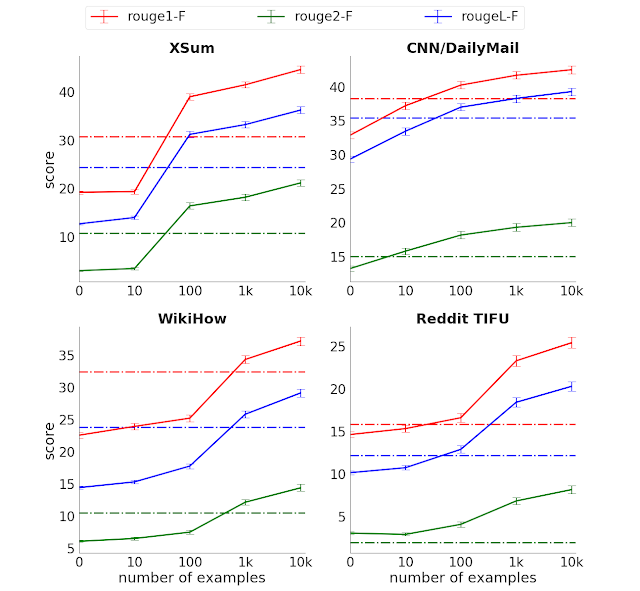Students are often tasked with reading a document and producing a summary (for example, a book report) to demonstrate both reading comprehension and writing ability. This abstractive text summarization is one of the most challenging tasks in natural language processing, involving understanding of long passages, information compression, and language generation. The dominant paradigm for training machine learning models to do this is sequence-to-sequence (seq2seq) learning, where a neural network learns to map input sequences to output sequences. While these seq2seq models were initially developed using recurrent neural networks, Transformer encoder-decoder models have recently become favored as they are more effective at modeling the dependencies present in the long sequences encountered in summarization.
Transformer models combined with self-supervised pre-training (e.g., BERT, GPT-2, RoBERTa, XLNet, ALBERT, T5, ELECTRA) have shown to be a powerful framework for producing general language learning, achieving state-of-the-art performance when fine-tuned on a wide array of language tasks. In prior work, the self-supervised objectives used in pre-training have been somewhat agnostic to the down-stream application in favor of generality; we wondered whether better performance could be achieved if the self-supervised objective more closely mirrored the final task.
In “PEGASUS: Pre-training with Extracted Gap-sentences for Abstractive Summarization” (to appear at the 2020 International Conference on Machine Learning), we designed a pre-training self-supervised objective (called gap-sentence generation) for Transformer encoder-decoder models to improve fine-tuning performance on abstractive summarization, achieving state-of-the-art results on 12 diverse summarization datasets. Supplementary to the paper, we are also releasing the training code and model checkpoints on GitHub.
A Self-Supervised Objective for Summarization
Our hypothesis is that the closer the pre-training self-supervised objective is to the final down-stream task, the better the fine-tuning performance. In PEGASUS pre-training, several whole sentences are removed from documents and the model is tasked with recovering them. An example input for pre-training is a document with missing sentences, while the output consists of the missing sentences concatenated together. This is an incredibly difficult task that may seem impossible, even for people, and we don’t expect the model to solve it perfectly. However, such a challenging task encourages the model to learn about language and general facts about the world, as well as how to distill information taken from throughout a document in order to generate output that closely resembles the fine-tuning summarization task. The advantage of this self-supervision is that you can create as many examples as there are documents, without any human annotation, which is often the bottleneck in purely supervised systems.
 |
| A self-supervised example for PEGASUS during pre-training. The model is trained to output all the masked sentences. |
Similar to other recent methods, such as T5, we pre-trained our model on a very large corpus of web-crawled documents, then we fine-tuned the model on 12 public down-stream abstractive summarization datasets, resulting in new state-of-the-art results as measured by automatic metrics, while using only 5% of the number of parameters of T5. The datasets were chosen to be diverse, including news articles, scientific papers, patents, short stories, e-mails, legal documents, and how-to directions, showing that the model framework is adaptive to a wide-variety of topics.
Fine-Tuning with Small Numbers of Examples
While PEGASUS showed remarkable performance with large datasets, we were surprised to learn that the model didn’t require a large number of examples for fine-tuning to get near state-of-the-art performance:
 |
| ROUGE scores (three variants, higher is better) vs. the number of supervised examples across four selected summarization datasets. The dotted-line shows the Transformer encoder-decoder performance with full-supervision, but without pre-training. |
Human-Quality summaries
While we find automatic metrics such as ROUGE are useful proxies for measuring progress during model development, they only provide limited information and don’t tell us the whole story, such as fluency or a comparison to human performance. To this end, we conducted a human evaluation, where raters were asked to compare summaries from our model with human ones (without knowing which is which). This has some similarities to the Turing test.
 |
| Human raters were asked to rate model and human-written summaries without knowing which was which. The document is truncated here for illustration, but raters see the full text. |
A Test of Comprehension: Counting Ships
Following this post is an example article from the XSum dataset and the model-generated abstractive summary. As we can see, the model correctly abstracts and paraphrases four named frigates (HMS Cumberland, HMS Campbeltown, HMS Chatham and HMS Cornwall) as “four Royal Navy frigates”, something an extractive approach could not do since “four” is not mentioned anywhere. Was this a fluke or did the model actually count? One way to find out is to add and remove ships to see if the count changes.
As can be seen below, the model successfully “counts” ships from 2 to 5. However, when we add a sixth ship, the “HMS Alphabet”, it miscounts it as “seven”. So it appears the model has learned to count small numbers of items in a list, but does not yet generalize as elegantly as we would hope. Still, we think this rudimentary counting ability is impressive as it was not explicitly programmed into the model, and it demonstrates a limited amount of “symbolic reasoning” by the model.
PEGASUS code and model release
To support on-going research in this field and ensure reproducibility, we are releasing the PEGASUS code and model checkpoints on GitHub. This includes fine-tuning code which can be used to adapt PEGASUS to other summarization datasets.
Acknowledgements
This work has been a collaborative effort involving Jingqing Zhang, Yao Zhao, Mohammad Saleh, and Peter J. Liu. We thank the T5 and Google News teams for providing datasets for pre-training PEGASUS.